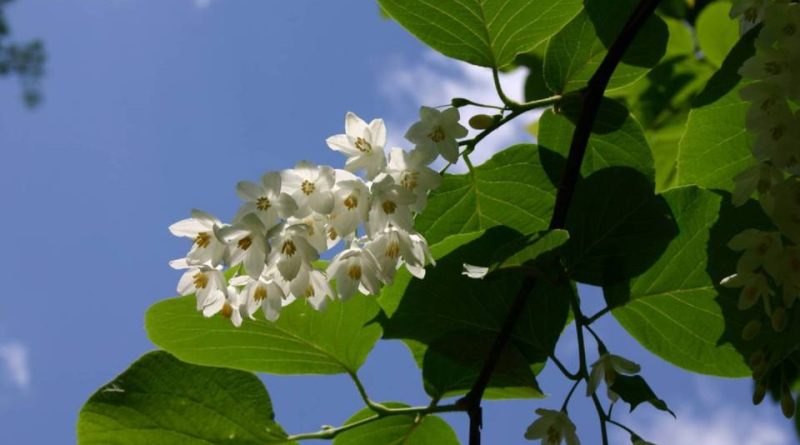Styrax paralleloneurum
Styrax paralleloneurum
Sumatran benzoin (Styrax paralleloneurum Perkins, 1902) is an arboreal species belonging to the Styracaceae family.
Systematics –
From a systematic point of view it belongs to:
Eukaryota Domain,
Kingdom Plantae,
Subarign Tracheobionta,
Magnoliophyta Division,
Magnoliopsida class,
Ericales Order,
Styracaceae family,
Genus Styrax,
S. paralleloneurum species.
The terms are synonymous:
– Styrax siamensis Rordorf;
– Styrax sumatranus J.J.Sm ..
Etymology –
The term Styrax comes from the Greek στῠραξ stýrax styrax, an aromatic resinous plant; according to some authors this name is derived from the Arabic as (si) tirax, resin that is extracted from different plants, especially Styrax officinalis, according to others it is the Arabic name that derives from the ancient Greek.
The specific epithet paralleloneurum, probably derives from the Latin parallelus, asua time derived from the Greek παράλληλος formed by παρά that is “near, along and from ἄλληλος or” each other “and from the ancient Greek term νευρο- (neuro-), which combines the form of νεῦρον (neûron, “sinew, sinew, chord”).
Geographic Distribution and Habitat –
Styrax paralleloneurum is a native plant, probably from the island of Sumatra and present in other areas of Indonesia, Java and East Asia.
Its habitat is that of tropical areas and forests, with a warm temperate climate and organic soils.
Description –
Styrax paralleloneurum is an arboreal or shrubby plant that can reach 10 meters in height.
The leaves are oval, whole and covered with whitish fluff.
The white flowers are grouped.
Its fruit is ovoid, 1 cm in diameter, containing a seed.
Cultivation –
Styrax paralleloneurum is a plant used, or even cultivated, for its resin and for its timber.
The plant prefers warm and humid temperate climates and can grow in both shady and sunny areas.
Propagation occurs by seed but can also be multiplied by cuttings.
Customs and Traditions –
The Styrax paralleloneurum is a plant that we find above all in Malaysia and Java where it is present both in the natural and cultivated state, both for the wood and for the resin. This plant is the source of white benzoin.
The extracted resin has a balsamic effect both for the upper respiratory tract and for intestinal regularity.
It is an expectorant, disinfectant and antiseptic. It is used to treat eczema, boils and chilblains.
It is also added to toothpastes for the treatment of oral conditions.
Some people owe it directly to the skin to kill germs, reduce swelling, and stop bleeding from small cuts. Benzoin is also used topically for skin ulcers, pressure sores and cracked skin. In combination with other herbs (aloe, styrax and tolu balm), benzoin is used as a skin protector. This combination is known as a “compound benzoin tincture”.
In addition, benzoin is used to treat hoarseness (laryngitis) and other respiratory diseases.
It is also used in the manufacture of drugs.
Preparation Method –
From Styrax paralleloneurum, through incisions in the trunk, a resinous liquid gushes out which, once dried, is marketed as an aromatic incense called white benzoin.
It is used by people both orally for swelling (inflammation) of the throat and airways and for other uses.
Guido Bissanti
Sources
– Acta Plantarum – Flora of the Italian Regions.
– Wikipedia, the free encyclopedia.
– GBIF, the Global Biodiversity Information Facility.
– Useful Tropical Plants Database.
– Conti F., Abbate G., Alessandrini A., Blasi C. (ed.), 2005. An annotated checklist of the Italian vascular flora, Palombi Editore.
– Pignatti S., 1982. Flora of Italy, Edagricole, Bologna.
– Treben M., 2000. Health from the Lord’s Pharmacy, Advice and experiences with medicinal herbs, Ennsthaler Editore.
Photo source:
– https://live.staticflickr.com/65535/48906854123_c39a0e329b_o_d.jpg
Warning: Pharmaceutical applications and alimurgical uses are indicated for informational purposes only, they do not represent in any way a medical prescription; therefore no responsibility is taken for their use for curative, aesthetic or food purposes.


